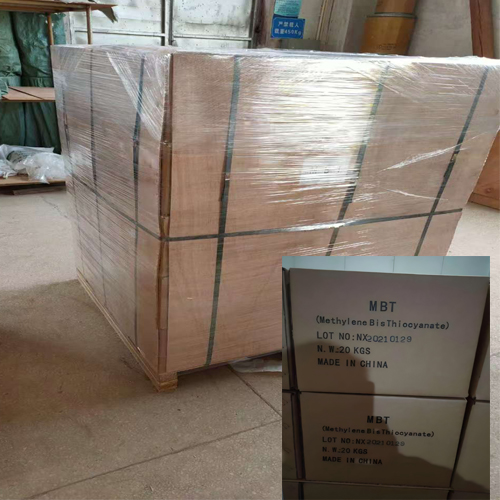
Brief introduction:
Methylene Bis Thiocyanate is a light yellow acicular crystalline chemical. Its melting point is 100-104℃, sight soluble in other organic solvents, soluble in water at the degree of 0.4%, and stable under acid conditions.
Methylene Bis Thiocyanate (MBT) which is a non-metallic organic sulfur biocide. Preservatives MBT is widely used in wood and leather protection.
Chemical Name:Methylene Bis Thiocyanate
CAS No: 6317-18-6
Formula:CH2(SCN)2
Molecular Weight: 130
Package: 20kg/carton, 9mt in one 20’FCL
Appearance | Pale Yellow free flowing powder / Crystals |
Melting Point | 101°C minimum |
Assay | 98% minimum |
Moisture | 0.5% maximum |
Acetone Insolubles | 1.0% maximum |
Inorganic Salts | 1.0% maximum |
Application:
Methylene bis(thiocyanate) biocide MBT is used as a microbiocide/microbiostat, fungicide/fungistat, algicide, and disinfectant.
Methylene bis(thiocyanate) is employed in water cooling systems, paint manufacturing, metalworking cutting fluids, pulp and paper mills, oil drilling/mud packing fluids, leather processing, wood pressure treatments (forest products), wood protection treatments to buildings/products, and latex paints (in-can).
Besides, Methylene bis(thiocyanate) MBT have below application:
1. Managing microbial activity in cooling water systems.
2. Controlling slime in pulp and paper manufacturing.
3. Preserving paints, adhesives, synthetic polymer lattices, and latex emulsions.
4. Applying anti-microbial treatment to water-thinned products, thickeners, and slurries.
5. Preserving wood and wood products.
6. Preserving leather and leather products.
7. Treating oil well brines and drilling mud.
Storage Notes: Sealed stored in cold, dry, good ventilated place, avoid high temperature and moist.
Advantages and dosage: Biocides Methylene bis(thiocyanate) MBT
Methylene bis(thiocyanate) MBT is an efficient and broad-spectrum germicide and algaecide that exhibits strong extermination effects on germs, fungi, and algae present in circulating water. Biocide MBT has long-term effects and is applicable within a wide range of pH values and temperatures.
Using 3-4 ppm of Methylene bis(thiocyanate) MBT can kill over 90% of nitrosation germs, sulfate reducing germs, colon bacillus, anti-nitrosation germs, and many other types of germs. MBT liquid is stable and can decompose quickly in application. It has an analysis method and is easy to monitor, making it safe for discharge.
Methylene bis(thiocyanate) MBT can increase oil production by reducing oil layer contamination, preventing clay from expanding, and disinfecting. It can also be used to protect packing paper from molding, treat circulating cooling water, and remove marine organisms from marine liners. It has excellent anti-corrosion, germicidal, and algaecidal effects for electrical materials, bamboo and wooden ware, coatings, rubber, canvas, glue, and ink.
A 1% emulsion of MBT is an efficient, broad-spectrum, and safe agricultural germicide with good effects against diseases of rice and wheat. Within the recommended quantity, it is safe for rice seeds and increases the germination percentage. As an organic thiocyano germicide, it can solve the problem of pesticide resistance developed by widely used absorbing germicides. When used in treating rice seeds, it does not require presoaking or post-washing and can be used directly for germination and seeding.
MBT can also be made into safe fish medicine to prevent various fish diseases. It is a good disinfectant in water for various breed aquatics.
Regulations of Methylene bis(thiocyanate) MBT for EPA in USA:
Regulatory History Methylene bis(thiocyanate) was first registered as a pesticide active ingredient in the United States in 1949. An Antimicrobial Data Call-In was issued in March l987 for methylene bis(thiocyanate). A second Data Call-In was issued as part of the Phase 4 reregistration in June 1991. The Agency issued a third Data Call-In in June 1993 for additional environmental fate data on aquatic exposure. A fourth Data Call-In was issued in April, 1997 for inhalation toxicity data. Currently, 59 methylene bis(thiocyanate) products are registered.
EPA has determined that products containing methylene bis (thiocyanate) are eligible for reregistration except products labeled for paint uses and ready-to-use products that are applied with a paint brush, roller or compressed air sprayer.
Properties of Methylene Bis Thiocyanate (MBT):

Contact us right now to get more information, professional advice will be supplied within 12 hours.
You can get a price of this model or send us any question to get any information you would like to know, we will reply to you soonest.